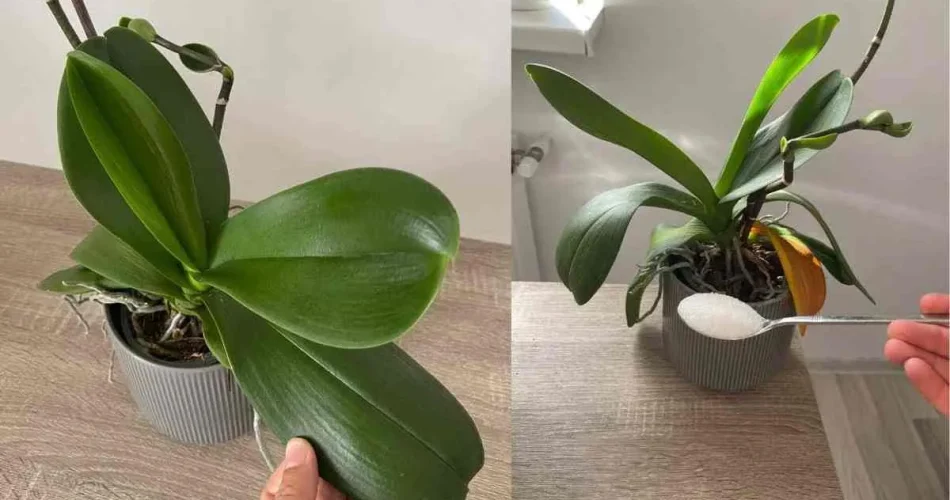
How to Water Your Orchid Properly : A Guide to Enhancing Blooms
Orchids are delicate plants that require precise care to thrive and produce stunning blooms consistently. To unravel the secrets of successful orchid care, I sought the expertise of Paul, a dedicated phalaenopsis enthusiast and the local nurseryman in my village. Paul’s knowledge proved invaluable, particularly when it comes to the crucial aspect of watering. Thanks to his guidance, my orchids now bloom without fail every year for several months. In this guide, you will learn how to water your orchids effectively to encourage abundant and frequent flowering.
How to Determine if Your Orchid Needs Water
The first step in orchid care is to assess whether your orchid is in need of watering. It’s crucial not to overwater, as orchids dislike having constantly wet roots. To determine if your orchid is thirsty, examine the potting mix. If it’s completely dry, that’s the initial sign. Additionally, the pot will feel exceptionally light. However, these indicators alone may not suffice. Observe the color of the aerial roots – the ones extending from the pot. If they appear white or silvery gray, it’s another sign that watering is required. Sometimes, the leaves may have a slightly wrinkled appearance. If you notice any of these three signs, it’s time to water your orchid.
Orchid Watering Frequency – Factors to Consider
The frequency of watering your orchid depends on various factors. Typically, it is recommended to water every 7 to 10 days, but this is a general guideline. Several factors influence the watering schedule:
- Season: Orchid activity varies with the seasons. During winter, when plants are less active, they require less water. From November to February, watering every two weeks is sufficient. However, in spring and during the flowering period, more frequent watering, approximately once a week, is needed.
- Ambient Temperature: Indoor orchids are affected by the room’s temperature. Houses can have dry air, especially with heating systems, making orchids thirstier. Regularly check for signs and adjust your watering accordingly, likely around once a week.
- Room Humidity: Phalaenopsis orchids thrive in humid tropical forests. If your indoor environment is dry, you’ll need to take extra precautions. Consider misting the leaves every few days or using a humidifier to maintain adequate humidity levels.
To ensure your orchid blooms again, it’s essential to provide the right watering regimen. While it may seem challenging at first, you’ll quickly become adept at understanding your plants’ needs.
Smart Summer Vacation Watering Strategy
In nature, orchids are epiphytic plants, growing on other plants as support. During the summer, you can replicate this environment when going on vacation for an extended period. Hang your orchid pots beneath the foliage of a tree or place them near the base of a bush. This arrangement provides shade during the day and dew at night. Leave your orchids in this natural setting until mid-September when the nights begin to cool down. You’ll be pleasantly surprised when a new stem with buds emerges a few weeks later. This strategy never fails.
Properly Watering Phalaenopsis Orchids
Watering technique and quantity are equally important for orchid care. Paul emphasizes that orchids dislike excessive moisture and require well-draining potting mix. So, how should you water them effectively?
- Bathing: Yes, you can soak your orchid. Place the pot in a basin or bucket of water for at least an hour, allowing it to absorb the required moisture. Ensure proper drainage before returning the pot to its holder to prevent root rot.
- Spraying: Between baths or regular watering sessions, spraying your orchid is beneficial. It helps maintain the correct humidity level. You can spray water on the leaves, roots, and flowers every few days to keep the orchid healthy.
Choosing the Right Water for Your Orchids
Orchids do not thrive with hard water, so it’s advisable to avoid tap water. Instead, opt for fresh water, rainwater, or even demineralized water. Collecting rainwater can be an excellent choice. However, demineralized water is not ideal, as it lacks the necessary nutrients for regular growth and flowering. While some gardeners prefer these options, tap water, despite its mineral content, has not shown any adverse effects on the development of my phalaenopsis.
Fertilizing Your Orchids for Optimal Blooming
To encourage indoor orchids to bloom again, Paul suggests adding a bit of fertilizer, particularly during spring when the plant is actively growing and preparing to flower. Most commercially available “special orchid” fertilizers contain the right balance of potassium and phosphorus. However, if you prefer an entirely organic approach, homemade green manure can be used.



